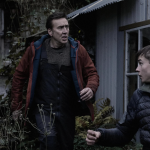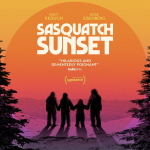A journey across a dystopian future America, following a team of military-embedded journalists as they race against time to reach DC before rebel factions descend upon the White House.
Chuck says:
I was worried Alex Garland’s “Civil War” would be cut from the same cloth as John Milius’ “Red Dawn,” the 1984 feature that posited a Russian invasion of the United States was an inevitability rather than a paranoid fantasy. To be sure, Garland’s film does, at times, have an air of exploitation about it. But there’s more at play here, the director effectively tapping into our collective fear, or desire, of democracy being declared dead and a violent, massive social and political upheaval taking place.
The plot is simplicity itself. Civil war has broken out, led by a coalition known as the Western Forces composed of the unlikely alliance of California and Texas. Some states are still a part of the established government, others are taking a wait-and-see approach. And after covering a conflict between police and civilians in New York City, four reporters hit the road, driving to Washington, D.C. in the vain hope they’ll be able to interview the president (Nick Offerman).
Veteran war photographer Lee Smith (Kirsten Dunst) has seen her share of armed conflict, her cynicism regarding human nature obvious. Her partner at Reuters, Joel (Wagner Moura) is a capable writer, but also an adrenaline junkie whose recklessness can be a liability. Jessie (Cailee Spaeny) is a rookie photographer who idolizes Lee, her lack of experience constantly putting her in harm’s way. Then there’s Sammy (Stephen McKinley Henderson), a veteran New York Times reporter who should be sitting behind a desk instead of entering a war zone.
Their trip south has them stumbling upon one tense situation after another. A stop at a gas station finds a group of armed locals who’ve strung up and tortured two neighbors who’ve been caught poaching; they are treated to the rare sight of people looking out for one another at an abandoned football stadium that’s been converted into a refugee camp; a sojourn to a college campus finds them in the middle of a firefight; and a wrong turn puts them in harm’s way from an unseen sniper.
As the journey unfolds, it’s against the backdrop of a dying nation. Random dead bodies are strewn about, smoke plumes bellow from the major cities, wild dogs run the streets and bodies are seen hanging from overpasses. Credit Garland for creating a plausible, nightmarish setting, his cinema verite approach when the characters are in the middle of armed conflict effectively puts the viewer in harm’s way, while the unpredictability of the characters’ actions creates a sense of palpable tension. This is in evidence during the film’s best scene in which an impulsive act finds the group at the mercy of militants whose leader (Jesse Plemons) takes no prisoners, a sequence that will likely have your stomach in knots.
There’s nothing new here as far as the examination of human behavior. Most any apocalyptic entertainment features examples of people giving into their basest desires and committing heinous acts once order collapses. But what’s different here is the immediacy of the film’s context. Without giving any specifics as to why war has broken out or citing any current real-life people who might attempt to foment or prevent it, he’s still able to exploit the viewer’s fears concerning our current political state.
To be sure, this is easy to do, and while the film’s trite ending does it no favors, its realism and sense of urgency make “Civil War” an effective piece of filmmaking. Is it a cautionary tale? An incitement for revolution? A crass piece of exploitation? I guess, like politics, it all depends on your perspective.
3 1/2 Stars




